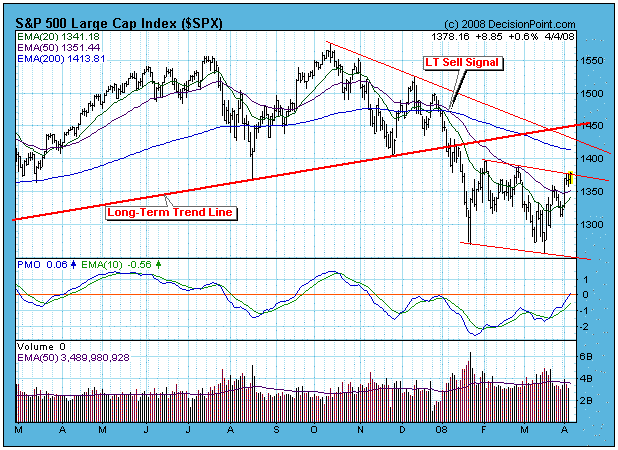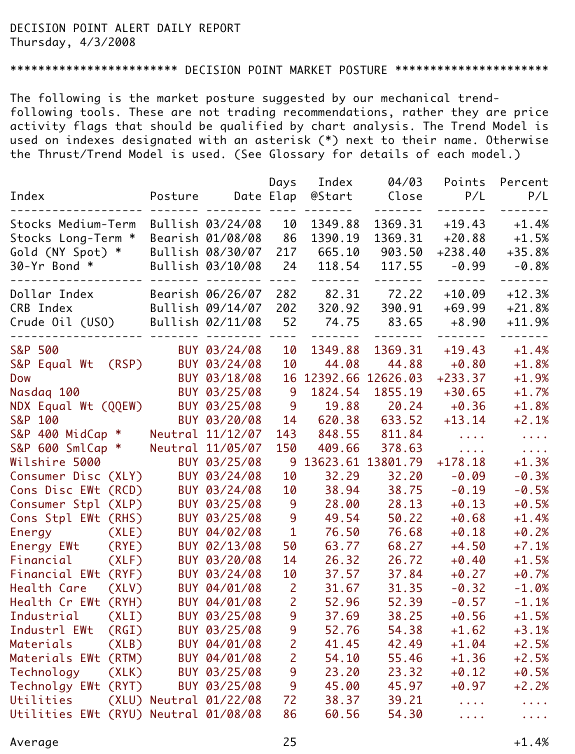As a technician I rarely look at fundamentals, primarily because they are not directly useful in making trading decisions; however, while fundamentals are not primary timing tools, they can be useful in establishing a broader context within which technical indicators can be interpreted. For example, one of the reports the Decision Point publishes daily is The Overview of Market Fundamentals. The following is an edited excerpt from that report.
First, notice that, in spite of a substantial market decline, the current P/E is 20.7, which is slightly above the overbought limit of the historical range. Notice also that GAAP earnings are projected to drop to 55.15 by the end of 2008 Q2. Compare that to earnings of 84.92 at the end of 2007 Q3. In spite of the fairy tale projections of "operating" earnings, real earnings are crashing.
*************************** S&P 500 FUNDAMENTALS ****************************
The real P/E for the S&P 500 is based on "as reported" or GAAP earnings (calculated using Generally Accepted Accounting Principals), and it is the standard for historical earnings comparisons. The normal range for the GAAP P/E ratio is between 10 (undervalued) to 20 (overvalued).
Market cheerleaders invariably use "pro forma" or "operating earnings," which exclude some expenses and are deceptively optimistic. They are useless and should be ignored.
The following are the most recently reported and projected twelve-month trailing (TMT) earnings and price/earnings ratios (P/Es) according to Standard and Poors.
| 2007 Q4 | Est 2008 Q1 | Est 2008 Q2 | Est 2008 Q3 | |
|---|---|---|---|---|
| TMT P/E Ratio (GAAP) | 20.7 | 22.5 | 24.8 | 23.6 |
| TMT P/E Ratio (Operating) | 16.6 | 16.9 | 16.9 | 16.1 |
| TMT Earnings (GAAP) | 66.18 | 60.95 | 55.15 | 57.92 |
| TMT Earnings (Operating) | 82.54 | 81.08 | 81.17 | 85.20 |
Based upon the latest GAAP earnings the following would be the approximate S&P 500 values at the cardinal points of the normal historical value range. They are calculated simply by multiplying the GAAP EPS by 10, 15, and 20:
Undervalued (SPX if P/E = 10): 662 Fair Value (SPX if P/E = 15): 993 Overvalued (SPX if P/E = 20): 1324
The following chart helps put current events into an historical perspective, showing the earnings crash that accompanied the last bear market, as well as the current earings decline. I don't know how anyone could be optimistic about this picture.
Now let's turn to the technical market picture. The chart below shows that the long-term sell signal is still in force; however, a nice looking bottom has formed and could be a solid base for a medium-term rally. As I write this the market is still open on April 4 and the S&P 500 is trying to break out of a three-month trading range. Also, most of our medium-term indicators (not shown) have reached very oversold levels and have formed positive divergences. Finally, we have medium-term buy signals on most of the indexes and sectors we track. Evidence is pretty strong that we are beginning a rally that will challenge important overhead resistance, possibly around the area of 1450 on the S&P 500.
Bottom Line: The earnings picture is abysmal, and there is a solid long-term sell signal in progress. Playing the long side looks promising, but keep a tight reign on long positions because we are in a bear market until proven otherwise. Remember: "Bear market rules apply! The odds are that support levels will be violated, and, if against those odds the market manages to rally off support, odds are that the rally will fail before it can change the long-term trend."
We rely on the mechanical trend models to determine our market posture. Below is a recent snapshot of our primary trend-following timing model status for the major indexes and sectors we track. Note that we have included the nine Rydex Equal Weight ETF versions of the S&P Spider Sectors. This may seem redundant, but the equal weighted indexes most often do not perform the same as their cap-weighted counterparts, and they provide a way to diversify exposure.









